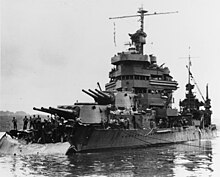
Back معركة تاسافارونغا Arabic Batalla de Tassafaronga AST Emgann Tassafaronga Breton Bitva u Tassafarongy Czech Slaget ved Tassafaronga Danish Schlacht bei Tassafaronga German Batalo ĉe Tassafaronga Esperanto Batalla de Tassafaronga Spanish نبرد تاسافارونگا Persian Bataille de Tassafaronga French
| Battle of Tassafaronga | |||||||
|---|---|---|---|---|---|---|---|
| Part of the Pacific Theater of World War II | |||||||
 USS Minneapolis at Tulagi with torpedo damage, 1 December 1942 | |||||||
| |||||||
| Belligerents | |||||||
|
|
| ||||||
| Commanders and leaders | |||||||
|
|
| ||||||
| Units involved | |||||||
| |||||||
| Strength | |||||||
| 8 destroyers |
4 heavy cruisers 1 light cruiser 6 destroyers | ||||||
| Casualties and losses | |||||||
|
197–211 killed[1] 1 destroyer sunk |
395–417 killed[2] 1 heavy cruiser sunk 3 heavy cruisers severely damaged | ||||||
The Battle of Tassafaronga, sometimes referred to as the Fourth Battle of Savo Island or in Japanese sources as the Battle of Lunga Point (ルンガ沖夜戦, "Night Battle off Lunga"), was a nighttime naval battle that took place on 30 November 1942 between United States Navy and Imperial Japanese Navy warships during the Guadalcanal campaign. The battle took place in Ironbottom Sound near Tassafaronga Point on Guadalcanal.
In the battle, a US force of five cruisers and four destroyers under the command of Rear Admiral Carleton H. Wright intercepted eight Japanese destroyers attempting to deliver food to their forces on Guadalcanal. The US destroyers waited four minutes after radar contact for permission to launch torpedoes and missed the optimal firing position; the torpedoes all missed, and the destroyers retired. The US cruisers opened fire and sank one destroyer. The muzzle flash exposed the US cruisers' positions. Under the command of Rear Admiral Raizō Tanaka, Japanese destroyers quickly launched Type 93 "Long Lance" torpedoes, sinking one US cruiser and heavily damaging three others. The rest of Tanaka's force escaped undamaged but failed to complete the intended supply mission.
Rear Admiral Samuel J. Cox, director of the Naval History and Heritage Command, considers this battle and the Battle of Savo Island to be two of the worst defeats in US naval history, behind only Pearl Harbor.[3][4][5]
- ^ Nevitt, Allyn D., Combinedfleet.com: IJN Takanami, accessed April 2, 2008. Dull, p. 255; Evans, pp. 202–203; Kilpatrick, p. 146; Frank, p. 513. Of Takanami's crew, Frank says 33 survived and Kilpatrick says 26 were captured by the Americans. Dull & Frank says 211 of the crew died.
- ^ Frank, p. 516. Crenshaw, p. 99, quotes a report by Chester Nimitz stating that 398 men and 19 officers were killed in the battle.
- ^ "Solomons Campaign: Guadalcanal". Naval History and Heritage Command.
The Japanese were able to inflict heavy damage on the U.S. ships, but were unable to complete their resupply mission, with deleterious effects for their troops on Guadalcanal.
- ^ "H-Gram 009: Savo Island". H-Gram. No. 9. Naval History and Heritage Command. 8 August 2017.
the naval battles around Guadalcanal were bookended with two of the worst defeats in U.S. naval history (Savo Island and Tassafaronga), eclipsed only by Pearl Harbor.
- ^ "H-013-1 The Battle of Tassafaronga". H-Gram. No. 13. Naval History and Heritage Command. 7 December 2017.
Thus ended one of the most ignominious defeats in U.S. Navy history, although technically Wright and TF-67 succeeded in their mission, since none of the supplies from Tanaka's destroyers made it ashore to starving Japanese troops on Guadalcanal.
© MMXXIII Rich X Search. We shall prevail. All rights reserved. Rich X Search